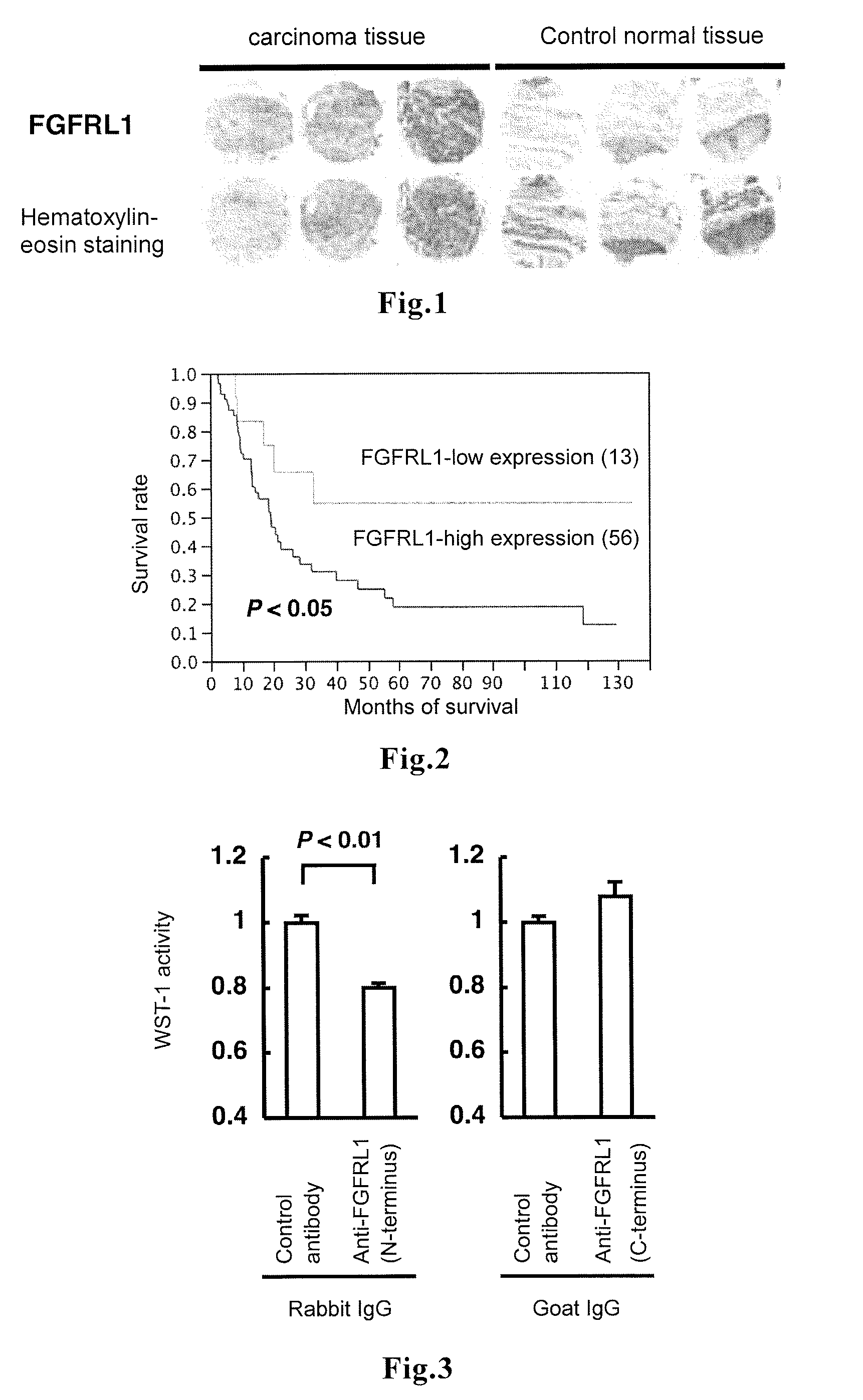Therapeutic agent for cancer, and method for determining prognosis of cancer
a cancer and prognosis technology, applied in the field of cancer therapy, can solve the problems of no statistical analysis, no analysis of the function of fgfrl1, no statistical analysis, etc., and achieve the effects of less invasiveness, easy detection of cancer, and light burden on the subj
- Summary
- Abstract
- Description
- Claims
- Application Information
AI Technical Summary
Benefits of technology
Problems solved by technology
Method used
Image
Examples
example 1
Immunohistochemical Staining
[0030]Tissue sections were prepared from esophageal squamous cell carcinoma tissues collected from 69 esophageal squamous cell carcinoma patients, and subjected to deparaffinization (3 times of 5 minutes of immersion in xylene, 2 times of 3 minutes of immersion in 100% ethanol, 3 minutes of immersion in 95% ethanol, 3 minutes of immersion in 90% ethanol, 3 minutes of immersion in 85% ethanol, 5 minutes of washing with running water, and then 5 minutes of immersion in distilled water) and then antigen retrieval by heat treatment (treatment in 1 mM Tris buffer (pH 9.0) supplemented with 0.1 mM EDTA at 95° C. for 40 minutes, followed by allowing the resultant to cool at room temperature for 20 minutes, washing with running water and then immersion in distilled water). Subsequently, endogenous peroxidase was blocked with 3% hydrogen peroxide solution (at room temperature for 10 minutes), and the sections were then washed with distilled water 3 times, followed...
example 2
Pharmacological Effect
[0032]An esophageal squamous cell carcinoma-derived cell line KYSE-170 was plated in Ham F12 (Nissui) / RPMI1640 (Gibco) medium (pH 6.8) supplemented with fetal bovine serum (5%, Equitech-Bio) filtered through a 0.22-μm PVDF membrane filter (Millipore), penicillin (100 unit / ml, Meiji), gentacin (4.44 mg / l, Schering) and sodium hydrogen carbonate (0.2%) on a 96-well dish (5×103 cells / 100 μL / well), and cultured under the conditions of 5% CO2, a humidity of 100% and a temperature of 37° C. Twenty four hours later, the cells were treated with anti-FGFRL1 antibody H-300 (recognition site: N-terminus / extracellular region) or C-20 (recognition site: C-terminus / intracellular region) (Santa cruse) and a control IgG (Santa cruse) of the animal from which it was derived, which were diluted with the above-described Ham F12 / RPMI1640 medium (final concentration, 20 μg / ml ). After 24 hours of culture, the cell growth was evaluated by the well-known WST1 method using a commercia...
PUM
| Property | Measurement | Unit |
|---|---|---|
| temperature | aaaaa | aaaaa |
| pH | aaaaa | aaaaa |
| pH | aaaaa | aaaaa |
Abstract
Description
Claims
Application Information
 Login to View More
Login to View More - R&D
- Intellectual Property
- Life Sciences
- Materials
- Tech Scout
- Unparalleled Data Quality
- Higher Quality Content
- 60% Fewer Hallucinations
Browse by: Latest US Patents, China's latest patents, Technical Efficacy Thesaurus, Application Domain, Technology Topic, Popular Technical Reports.
© 2025 PatSnap. All rights reserved.Legal|Privacy policy|Modern Slavery Act Transparency Statement|Sitemap|About US| Contact US: help@patsnap.com

